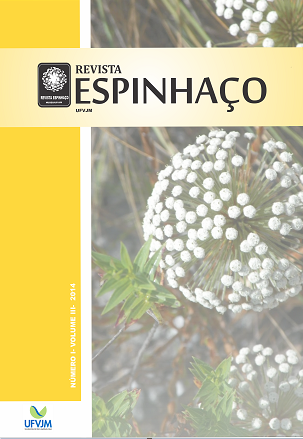A demographic reflection of environmental change in Brazil
DOI:
https://doi.org/10.5281/zenodo.3966160Keywords:
population, the environment, demographic transition, agingAbstract
The relationship between population and environment have gained increasing attention of demographers in Brazil,
however, without being consolidated what is proper of demography in regarding the environmental. This article seeks to
contribute to this discussion by showing that specific issues of demographic analysis have much to contribute to the understanding
of relationship between people, society and environment in Brazil. Dealing with aspects such as life cycle, age and cohort, the article draw attention to how an ageing structure of the population, experienced in the next decades, could be related to environmental change. The accelerated aging of the population could have a significant impact on patterns of consumption of our society as well as changing the population's vulnerability to environmental conditions experienced in the future.
References
ABRAMSON, P. R, E INGLEHART, R. Generational Replacement and the Future of Post-Materialist Values. The Journal of Politics, v. 49, n. 1.,p. 231-241, 1987.
BARBIERI, A. F. Mobilidade populacional, meio ambiente e uso da terra em áreas de fronteira: uma abordagem multiescalar. Revista Brasileira de Estudos Populacionais, Campinas, v. 24, n. 2, p. 225- 246, 2007.
CARLSSON-KANYAMA, A. ; LINDEN, A.-L. Travel patterns and environmental effects now and in the future: implications of differences in energy consumption among socio-economic groups. Ecological Economics. v.30, n.1, p.405-417,1999.
COLE, M. A.; NEUMAYER, E. Examining the Impact of Demographic Factors On Air Pollution. Population and Environment, v. 26, n. 1, 2004.
GREIDER, T.; GARKOVICH, L. Landscapes: The social construction of nature and the environment. Rural Social., v.59 n.1, p. 1–24. 1994.
GRENNING, L.A.; JENG, T.H. Lifecycle analysis of gasoline expenditure patterns. Energy Economics v.16, n.3, p. 217-228. 1994.
HAMMEL, E. A. Chayanov revisited: a model for the economics of complex kin units. PNAS, v. 102, n. 19, p. 7043-7046, 2005.
HOGAN, D. J.; MARANDOLA JR., E. População e Mudanças Climática: Dimensões humanas das mudanças ambientais globais. Brasilia: UNFPA, 2009.
IBGE. Projeção da População do Brasil e Unidades da Federação. Rio de Janeiro: IBGE, 2013.
JIANG, L.; HARDEE, K. How do recent population trends matter to climate change? Washington, D.C.: Population Action International, 2009.
MANNHEIM, K. (1993). “El problema de las generaciones” [tradução: Ignacio Sánchez de la Yncera], Revista Española de Investigaciones Sociológicas (REIS), n. 62, p. 193-242.
MARANDOLA JR, E. HOGAN, D. J. Em direção a uma demografia ambiental? Avaliação e tendências dos estudos de população e ambiente no Brasil. Revista Brasileira de Estudos Populacionais. v.24, n.2, p.191-223, 2007.
MARTINE, G. (Ed.). População e Sustentabilidade na era das Mudanças Ambientais Globais. Belo Horizonte: ABEP, 2012.
MARTINE, G. ; OJIMA, R. ; FIORAVANTE, E. F. Transporte individual, dinâmica demográfica e meio ambiente. In: MARTINE, G. ; OJIMA, R. ; BARBIERI, F.; CARMO, R. L. do (Org.). População e sustentabilidade na era das mudanças ambientais globais: contribuições para uma agenda brasileira. Belo Horizonte: ABEP, 2012.
MOTTA, A. B. E WELLER, W. Apresentação: A atualidade do conceito de gerações na pesquisa sociológica. Sociedade e Estado. v.25, n.2, Brasília: 2010.
O’NEILL B. C.; CHEN B.S. Demographic determinants of household energy use in the United States. Population and Development Review, 2002.
OJIMA, R. As dimensões demográficas das mudanças climáticas: cenários de mudança do clima e as tendências do crescimento populacional. Revista Brasileira de Estudos Populacionais. Rio de Janeiro, v. 28, n. 2, p. 389-403, 2011.
PERZ, S. G. Household demographic factors as life cycle determinants of land use in the Amazon. Population Research and Policy Review, Amsterdam, v. 20, n. 3, p. 159-186, 2001.
PRESTON, S. H.; HEUVELINE, P.; GUILLOT, M. Demography: measuring and modeling population processes. Oxford: Blackwell Publishers, 2001.
PRSKAWETZ, A.; LEIWEN J.;. O'NEILL, B. C. Demographic composition and Projections of car use in Austria, Vienna Yearbook of Population Research, v. 2, n.1 p. 175-201, 2004.
RYDER, N. B. The Cohort as a Concept in the Study of Social Change. American Sociological Review v.30, n.1 p.843–61,1965.
TORRES, H.; COSTA, H. (Org.). População e Meio Ambiente: debates e desafios. São Paulo: SENAC, 2000.
WALKER, R. et al. Land use and land cover change in forest frontiers: the role of household life cycles. International Regional Science Review, Philadelphia, v. 25, n. 2, p. 169-199, 2002.
WRAY-LAKE, L., FLANAGAN, C.A., OSGOOD, W. Examining Trends in Adolescent Environmental Attitudes, Beliefs, and Behaviors across Three Decades. Environment and Behavior. v. 42, n.1, p. 61–85, 2010.
YAMASAKI, E.; TOMINAGA N. Evolution of an aging society and effect on residential energy demand. Energy Policy. v. 25, n.11, p.903-912, 1997.
Downloads
Published
How to Cite
Issue
Section
License
Copyright (c) 2022 Revista Espinhaço

This work is licensed under a Creative Commons Attribution-NonCommercial-NoDerivatives 4.0 International License.


